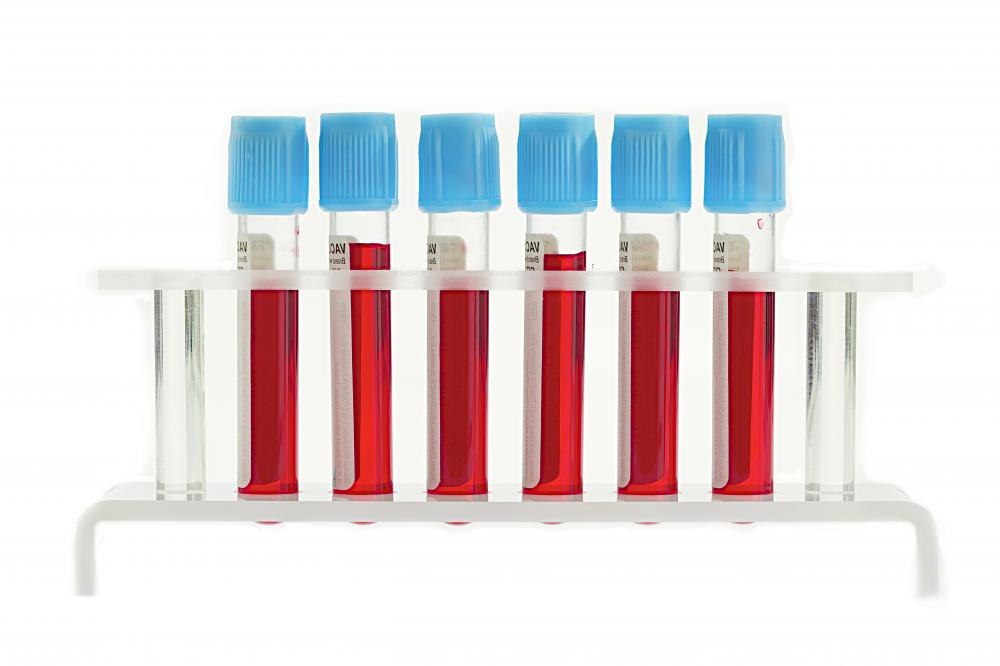At WiseGEEK, we're committed to delivering accurate, trustworthy information. Our expert-authored content is rigorously fact-checked and sourced from credible authorities. Discover how we uphold the highest standards in providing you with reliable knowledge.
What is a Blood Platelet Count?
Platelets are tiny cells that are part of blood products and they are extremely useful in helping blood to clot. Their shapes are usually described as similar to discs, but each individual platelet can be shaped somewhat differently and the term “irregular” is often applied to describe platelet shape. When injury occurs that causes bleeding, platelets are like emergency medical technicians or first responders. They rush to the bleeding and along with certain vitamins, minerals and proteins, form clots so bleeding will stop.
In the body, platelets have a lifespan of about a week or slightly longer, and the healthy body usually continues to produce these in vast amounts. Under certain circumstances people may have lower or higher than normal levels of platelets. Doctors may choose to measure this with a blood platelet count.

A blood platelet count may be part of other blood counts like a complete blood count (CBC). Usually the most common method for “counting” platelets is with a simple extraction of blood or blood draw. This is most often taken from veins on the opposite side of the elbow. Most blood tests of this type are not particularly painful, though those with fear of needles or low pain tolerance may feel some pain when they occur or be anxious about these tests.

It has to be understood that the body has huge amounts of platelets. A normal blood platelet count would generally be somewhere between 150,000-400,000 platelets per microliter of blood. A microliter is about one thousandth of a milliliter, and a single milliliter is approximately one third of an ounce. A single teaspoon contains about 5 ounces so it is easy to imagine the enormous amounts of platelets that would exist in a teaspoon of blood.

There are several different ways in which a blood platelet measurement may be obtained once blood is drawn. Two of the most common methods count platelets electronically and are called voltage-pulse and electro-optical methods. A third method called hemacytometer counting may be used too, but it is often thought slightly less accurate.
For the average person, counting methods are less important than actual blood platelet count and what it means. Lower than normal counts can indicate lots of different things including thrombocytopenia, or aplastic anemia. Sometimes certain medications like those used in chemotherapy lower blood platelet counts. In other circumstances, risk of blood clotting in conditions where veins or arteries are narrowed means that doctors want to reduce normal count and they may use medications like aspirin to do so, in order to prevent dangerous blood clotting.

A higher than normal blood platelet count can indicate presence of certain medical conditions too. It might suggest thrombocytosis, which places people for increased risk of abnormal clotting. There are other conditions that cause high platelet count and these usually need to be addressed medically in order to reduce risk of things like stroke. It should be noted that most people in good health will have blood platelet counts that fall within the normal range.
AS FEATURED ON:
AS FEATURED ON:















Discussion Comments
Sometimes a low white blood cell and platelet count show up together.
This can be an indication of anemia, hypoglycemia, and even porphyria.
In rare cases, this can also be a sign of an autoimmune disorder, and some kinds of cancers.
@Planch -- An elevated blood platelet count could be caused by a number of things other than thrombocytosis.
For instance, some types of cancer, including myelogenous leukemia, can cause an elevation in platelet counts, as can polycythemia vera, which is an increase in red blood cells.
However, the most common cause of an elevated platelet count is thrombocytosis, as the article said. This can happen as a reaction to IBS or arthritis, but more commonly happens due to infection.
What things could cause an increase in blood platelet count besides thrombocytosis?
Post your comments